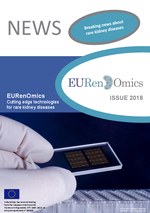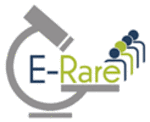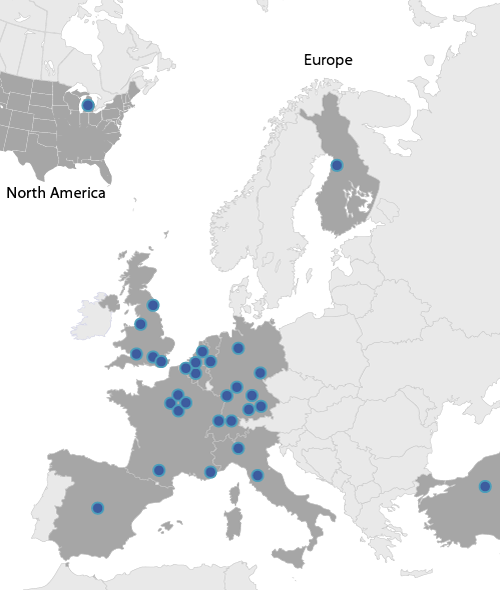EURenOmics Project Summary Year 2
Summary description of project context and objectives
Rare kidney diseases impact markedly on the life expectancy and quality of life of affected individuals. The current diagnostic and therapeutic management of rare kidney diseases is highly unsatisfactory. We are typically unable to explain the genetic or molecular abnormality underlying the disease phenotype, to predict the individual risk and rate of disease progression, or to quantitate the risk of relatives to develop the same disorder. Even in patients with known genetic causes, individual risk prediction is limited by considerable phenotypic variability. Molecular disease and progression risk markers are lacking. Effective therapies are largely unavailable; the lack of suitable disease models is a major barrier to progress in therapeutic development.
Diseases of the kidney are well suited to high-throughput research approaches due to the opportunity to examine molecular events in the end organ that is manifesting the disease: kidney biopsy, a standard diagnostic procedure, provides a unique opportunity to study intrarenal biological processes ex vivo using transcriptomic, proteomic and morphological approaches. Urine is a readily available non-invasive bioresource to study molecular readouts directly derived from the organ of interest, the kidney. Amniotic fluid, the fetal urine, allows prenatal epigenetic, proteomic and metabolomic profiling in the context of renal maldevelopment. Recent technological progress in exosome isolation from urine and amniotic fluid even has created the opportunity to study non-invasively cellular biomaterials originating from the diseased tissues.
EURenOmics has prioritized five disease groups based on their urgent need and significant potential for diagnostic and therapeutic progress: Steroid-resistant nephrotic syndrome, membranous nephropathy, tubulopathies, complement disorders and malformations of the kidney and urinary tract. The consortium has access to a unique assembly of large existing patient cohorts and biorepositories, encompassing more than 15,000 patients with >10,000 DNA, >3,000 serum, 2,000 urine, 500 amniotic fluid and 3,000 kidney biopsy specimens. Some 30 academic and industry partners have joined EURenOmics to apply a wide range of high-throughput technologies, innovative systems biology approaches and a plethora of in vitro, ex vivo and in vivo models to study disease mechanisms and explore novel therapeutic approaches.
Initial research efforts focus on methodological standardization, involving procedures for acquisition and processing of biospecimens but also the construction of an integrated phenome database for uniform clinical phenotyping. The next objective is to search for new genes causing, modifying or predisposing to individual disease phenotypes. Screening strategies encompass next-generation sequencing of known genes, regulatory regions, exomes and whole genomes, application of cutting-edge bioinformatic tools for data mining, filtering and gene network analysis, and extensive genotype-phenotype analyses utilizing standardized phenotypic information. Novel epitopes/antigens and antibodies are searched systematically in those disorders in which an auto-immune pathology is suspected. The protein products of the newly identified gene variants, as well as the mechanisms of auto-antibody formation, are functionally characterized by an array of in vitro, ex vivo and in vivo technologies. Multi-level -omics profiling (mRNA, miRNA, peptidome/proteome, metabolome) in body fluids and renal tissues is performed to identify unique molecular disease signatures (deep phenotyping), develop a prognostically indicative new ontology of rare kidney diseases, discover molecular markers and pathways associated with disease activity and progression, and develop diagnostic tools and biomarkers. Finally, in vitro and in vivo models will be developed that allow high-throughput screening of compound libraries for novel therapeutic agents reversing or attenuating disease phenotypes.
Work performed since the beginning of the project and the main results achieved so far
Standard Operating Procedures for WP- and Consortium-wide use (specimen collection and processing, data transmission formats etc.) have been developed, and various novel methodologies (diagnostic and disease activity assays; in silico, in vitro and in vivo models) have been established. The consortium is jointly working on a central ‘phenome’ database integrating clinical information from all patient registries..In parallel, the WP7 partners have created, implemented and pre-filled the joint -Omics database with renal transcriptome datasets. Besides these preparatory activities, urine peptidomic and metabolomic studies have been initiated to provide ‘deep phenotyping’ in patient cohorts of WP2 and WP4.
Targeted NG sequencing assays capturing all known genes within each disease group have been developed in WP2 (glomerulopathy panel, 31 genes), WP4 (tubulopathy panel, 39 genes) and WP5 (complement panel, 28 genes) and optimized by iterative testing and multiplex-PCR redesign. NGS panel sequencing has been applied in 214 steroid-resistant nephrotic syndrome (SRNS), 66 tubulopathy and 29 (known) atypical hemolytic uremic syndrome (aHUS) cases so far. Disease causing mutations were identified in 20% of the SRNS and 76% of the tubulopathy cohorts, and correctly recovered in 27 of 29 aHUS patients. Following the successful development and implementation phase, NGS panel screening of all archived DNA samples and incident patients has been launched in the WP2, WP4 and WP5 partner laboratories.
In parallel, exome sequencing has been performed in 109 families (WP2: n=36, WP4: n=13, WP5: n=24, WP6: n=36). These efforts led to the discovery of 5 novel SRNS genes, 2 novel tubulopathy genes, 2 novel disease genes for aHUS, 1 novel gene causing CAKUT, and several new genomic rearrangements in complement disorders. Numerous additional candidate disease genes are currently undergoing functional characterization utilizing the wide range of in vitro, ex vivo and in vivo methodologies established in the partner laboratories. Moreover, causative mutations in known genes were found in 8 SRNS, 27 tubulopathy, 10 complement disease and 4 CAKUT families.
Fundamental new insights have been achieved regarding the mechanisms of variable genetic disease penetrance. In NPHS2 glomerulopathy, the expression of a phenotype in compound heterozygous patients was found to depend on the nature of the combining mutations. This discovery is the first description of mutation-dependent recessive inheritance in human genetics. In aHUS and CAKUT, enrichment of rare variants in renal developmental and compement regulating genes is emerging as an important determinant of disease predisposition.
Insights from the study of rare monogenic disorders have been used to identify general risk factors for progressive kidney diseases. WP4 partners have deciphered a mechanism by which allelic variants in UMOD, the gene causing familial juvenile hyperuricemic nephropathy, are associated with the risk of chronic kidney diseases and hypertension in the general population.
Major achievements have also been made with respect to the molecular mechanisms of auto-immune disease. In WP3, the B cell epitope in PLA2R, the target of specific autoantibodies in MN, has been identified. Moreover, academia and industry partners successfully collaborated in identifiying several hundred class I and more than 1000 class II MHC peptides, the HLA ‘peptidome’. This major technical breakthrough will pave the way for unbiased identification of the targets of immune responses in autoimmune diseases affecting the kidney and other organs.
Finally, initial progress has been made in the development of in vitro and in vivo models suitable for compound screening, including cell-based assays as well as Zebrafish and Xenopus models for SRNS, tubulopathies and complement disorders. A monoclonal complement blocking activation with major therapeutic potential has been successfully tested in in rodent models.
The expected final results and their potential impact and use (including the socio-economic impact and the wider societal implications of the project so far)
The research results expected from EURenOmics will have substantial impact on diagnostic management, risk assignment and preventative and therapeutic strategies in patients with rare kidney diseases, with potential implications also for patients with common kidney and other diseases and the society at large.
Comprehensive exome sequencing of large patient cohorts is profoundly advancing the state of knowledge by unraveling the as yet unknown monogenic and complex genetic causes underlying the diseases of interest. The newly discovered genes are continuously included in the targeted next-generation sequencing (NGS) gene arrays developed by the partners. The advent of these NGS panels is considered a major breakthrough as it will render the current sequencing technology with its high cost and time demands obsolete and will bring rapid and complete genetic diagnostics into routine clinical practice. For those patients in whom a genetic diagnosis cannot be established, we seek to develop disease-specific RNA, proteome and metabolome profiles and novel auto-antibody assays in the course of the project.
The availability of such rapid diagnostic tests will constitute a big step towards personalized medicine. The need for invasive kidney biopsies will be greatly reduced or eliminated. Exposure to ineffective, potentially toxic and costly medications can be avoided and replaced by rational, risk-adapted therapies tailored to the molecular basis of mechanistically defined disease entities. The recent development of a sensitive and specific bioassay that allows to monitor therapeutic complement blockade and prevent both hazardous under- and costly overtreatment with the C5 inhibitor eculizumab in complement disorders exemplifies the remarkable health and socio-economic impact of the Consortium’s activities.
In addition to the expected diagnostic progress, the anticipated identification of genetic disease causes and risk factors as well as prognostic biomarkers should greatly facilitate individual risk assignment regarding disease occurrence, progression, complications and post-transplant recurrence compared to the currently used clinical, histopathological or imaging criteria. The efficiency of genetic counselling to families with inherited disorders will be much improved, alleviating their psychological burden and distress. Also, accurate risk assignment will form a basis for the development of early intervention and secondary prevention protocols.
Moreover, the partners have started developing in vitro and in vivo disease models aimed to discover novel therapeutics including alternatives to existing superexpensive drugs, and to allow a more rational, calculated use of already available agents. Our preliminary results and ongoing research efforts with respect to in vitro and in vivo model development, the repurposed use of approved pharmaceutical agents to attenuate hereditary glomerulopathies and the development of a novel complement blocking monoclonal antibody look promising and will contribute to the IRDiRC goal of establishing new therapies for a significant number of rare diseases by 2020.
Finally, EURenOmics seeks to generate clinical and socioeconomic impact beyond the field of rare kidney disease. The study of the genetic abnormalities and molecular mechanisms underlying the selected disorders is hoped to produce insights into general mechanisms of kidney disease progression and even universal risk factors relevant to the general population. Our identification of a mechanism by which genetic variation of a kidney-specific protein involved in a rare kidney disorder predisposes to chronic kidney disease and hypertension impressively exemplifies the far reaching potential of rare kidney disease research.






